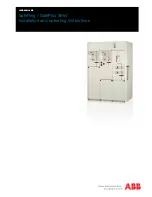
•
for 3 phase faults: loop L1 - L2.
•
for 2 phase faults: the loop between the faulted phases.
•
for 2 phase-to-earth faults: the loop between the faulted phases.
•
for phase-to-earth faults: the phase-to-earth loop.
LMBRFLO function indicates the distance to fault as a percentage of the line
length, in kilometers or miles as selected on the local HMI.
LineLengthUnit
setting
is used to select the unit of length either, in
kilometer
or
miles
for the distance to
fault. The distance to the fault, which is calculated with a high accuracy, is stored
together with the recorded disturbances. This information can be read on the local
HMI, uploaded to PCM600 and is available on the station bus according to IEC
61850–8–1.
The distance to fault can be recalculated on the local HMI by using the measuring
algorithm for different fault loops or for changed system parameters.
15.8.3
Setting guidelines
IP14835-1 v1
M13769-3 v6
The parameters for the Fault locator function are set via the local HMI or PCM600.
The Fault locator algorithm uses phase voltages, phase currents and residual
current in observed bay (protected line) and residual current from a parallel bay
(line, which is mutual coupled to protected line).
The Fault locator has close connection to the Disturbance report function. All
external analog inputs (channel 1-30), connected to the Disturbance report
function, are available to the Fault locator and the function uses information
calculated by the Trip value recorder. After allocation of analog inputs to the
Disturbance report function, the user has to point out which analog inputs to be
used by the Fault locator. According to the default settings the first four analog
inputs are currents and next three are voltages in the observed bay (no parallel line
expected since chosen input is set to zero). Use the Parameter Setting tool within
PCM600 for changing analog configuration.
The measured phase voltages can be fine tuned with the parameters
UL1Gain
,
UL2Gain
and
UL3Gain
to further increase the accuracy of the fault locator.
The list of parameters explains the meaning of the abbreviations. Figure
also
presents these system parameters graphically. Note, that all impedance values relate
to their primary values and to the total length of the protected line.
1MRK 505 393-UEN B
Section 15
Monitoring
Line differential protection RED650 2.2 IEC
345
Application manual
Summary of Contents for RED650
Page 1: ...RELION 650 SERIES Line differential protection RED650 Version 2 2 Application manual ...
Page 2: ......
Page 22: ...16 ...
Page 32: ...26 ...
Page 82: ...76 ...
Page 112: ...106 ...
Page 152: ...146 ...
Page 208: ...202 ...
Page 214: ...208 ...
Page 282: ...276 ...
Page 356: ...350 ...
Page 404: ...398 ...
Page 408: ...402 ...
Page 442: ...436 ...
Page 452: ...446 ...
Page 453: ...447 ...
















































